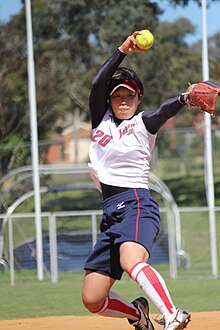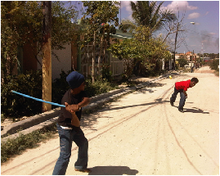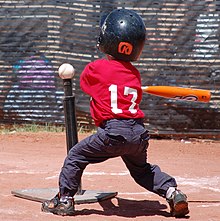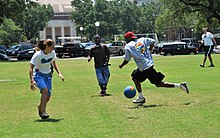In baseball, an earned run is any run that was fully enabled by the offensive team's production in the face of competent play from the defensive team. Conversely, an unearned run is a run that would not have been scored without the aid of an error or a passed ball committed by the defense.

In baseball statistics, a hit, also called a base hit, is credited to a batter when the batter safely reaches or passes first base after hitting the ball into fair territory with neither the benefit of an error nor a fielder's choice.
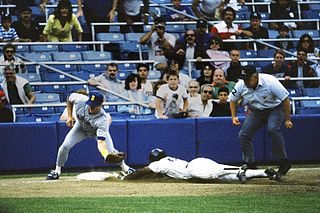
In baseball, a stolen base occurs when a runner advances to a base unaided by other actions and the official scorer rules that the advance should be credited to the action of the runner. The umpires determine whether the runner is safe or out at the next base, but the official scorer rules on the question of credit or blame for the advance under Rule 10 of the MLB's Official Rules.
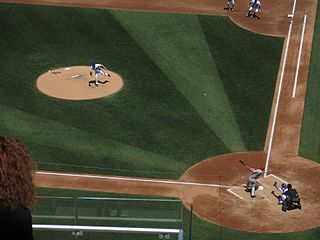
Baseball is a bat-and-ball sport played between two teams of nine players each, taking turns batting and fielding. The game occurs over the course of several plays, with each play generally beginning when a player on the fielding team, called the pitcher, throws a ball that a player on the batting team, called the batter, tries to hit with a bat. The objective of the offensive team is to hit the ball into the field of play, away from the other team's players, allowing its players to run the bases, having them advance counter-clockwise around four bases to score what are called "runs". The objective of the defensive team is to prevent batters from becoming runners, and to prevent runners' advance around the bases. A run is scored when a runner legally advances around the bases in order and touches home plate.

Rounders is a bat-and-ball game played between two teams. Rounders is a striking and fielding team game that involves hitting a small, hard, leather-cased ball with a wooden, plastic, or metal bat that has a rounded end. The players score by running around the four bases on the field.

Softball is a sport similar to baseball, and it is played with a larger ball on a smaller field and with only underhand pitches permitted. Softball is played competitively at club levels, the college level, and the professional level. The game was first created in 1887 in Chicago by George Hancock.

In baseball and softball statistics, an error is an act, in the judgment of the official scorer, of a fielder misplaying a ball in a manner that allows a batter or baserunner to advance one or more bases or allows a plate appearance to continue after the batter should have been put out. The term error is sometimes used to refer to the play during which an error was committed.
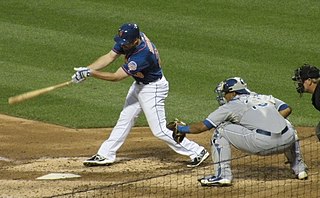
Catcher is a position in baseball and softball. When a batter takes their turn to hit, the catcher crouches behind home plate, in front of the (home) umpire, and receives the ball from the pitcher. In addition to this primary duty, the catcher is also called upon to master many other skills in order to field the position well. The role of the catcher is similar to that of the wicket-keeper in cricket.
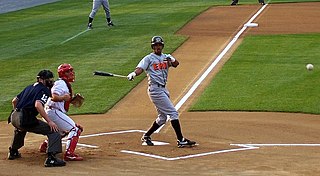
In baseball, a foul ball is a batted ball that:
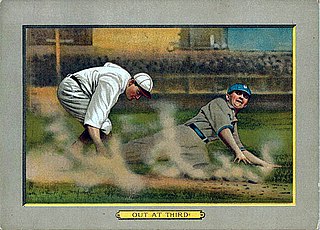
In baseball, an out occurs when the umpire rules a batter or baserunner out. When a batter or runner is out, they lose their ability to score a run and must return to the dugout until their next turn at bat. When three outs are recorded in a half-inning, the batting team's turn expires.

Kickball is a team sport and league game, similar to baseball. Like baseball, it is a safe haven game in which one team tries to score by having its players return a ball from home base to the field and then circle the bases. Meanwhile, the other team tries to stop them by tagging them "out" with the ball before they can return to the home base. However, instead of hitting a small, hard ball with a bat, players kick an inflated rubber ball; this makes it more accessible to young children. As in baseball, teams alternate half-innings. The team with the most runs after a predefined number of innings wins.

Throughout the history of baseball, the rules have frequently changed as the game continues to evolve. A few common rules most professional leagues have in common is that four balls is a base on balls, three strikes is a strikeout, and three outs end a half-inning.
Baseball and cricket are the best-known members of a family of related bat-and-ball games. Both have fields that are 400 feet (120 m) or more in diameter between their furthest endpoints, offensive players who can hit a thrown/"bowled" ball out of the field and run between safe areas to score runs (points) at the risk of being gotten out, and have a major game format lasting about 3 hours.

In the sports of baseball and softball, a batted ball is a pitch that has been contacted by the batter's bat. Batted balls are either fair or foul, and can be characterized as a fly ball, pop-up, line drive, or ground ball. In baseball, a foul ball counts as a strike against the batter, unless there are already two strikes on the batter, with special rules applying to foul tips and foul bunts. Fly balls are those hit in an arcing manner, with pop-ups being a subset of foul balls that do not travel far. Line drives are batted balls hit on a straight line trajectory, while ground balls are hit at a low trajectory, contact the ground shortly after being hit, and then either roll or bounce. Batted balls, especially line drives, can present a hazard to players, umpires, and spectators, as people have been seriously injured or killed after being struck by batted balls.
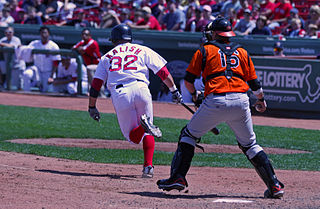
In baseball and softball, an uncaught third strike occurs when the catcher fails to cleanly catch a pitch for the third strike of a plate appearance. In Major League Baseball (MLB), the specific rules concerning the uncaught third strike are addressed in Rules 5.05 and 5.09 of the Official Baseball Rules:
An invisible runner, or ghost runner, is a device used in baseball-style games, including softball, stickball, and kickball, when a team does not have enough players. Used primarily in schoolyard games, the rule is called into action when a live runner on base is next in line to bat. The specifics of the rule vary regionally, and are often negotiated prior to the start of the game.
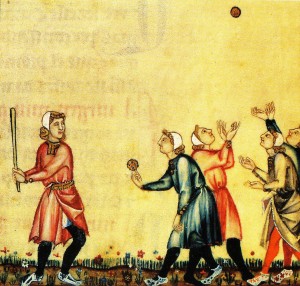
Bat-and-ball games are field games played by two opposing teams. Action starts when the defending team throws a ball at a dedicated player of the attacking team, who tries to hit it with a bat and run between various safe areas in the field to score runs (points). The defending team can use the ball in various ways against the attacking team's players to force them off the field when they are not in safe zones, and thus prevent them from further scoring. The best known modern bat-and-ball games are cricket and baseball, with common roots in the 18th-century games played in England.
This is an alphabetical list of selected unofficial and specialized terms, phrases, and other jargon used in baseball, along with their definitions, including illustrative examples for many entries.

Vitilla is a popular variation of stickball played primarily in the Dominican Republic and areas in the United States with large Dominican populations.

Baseball5 (B5) is an internationally played safe haven game with many of the same rules as baseball and softball, which is governed alongside those sports by the World Baseball Softball Confederation (WBSC).
